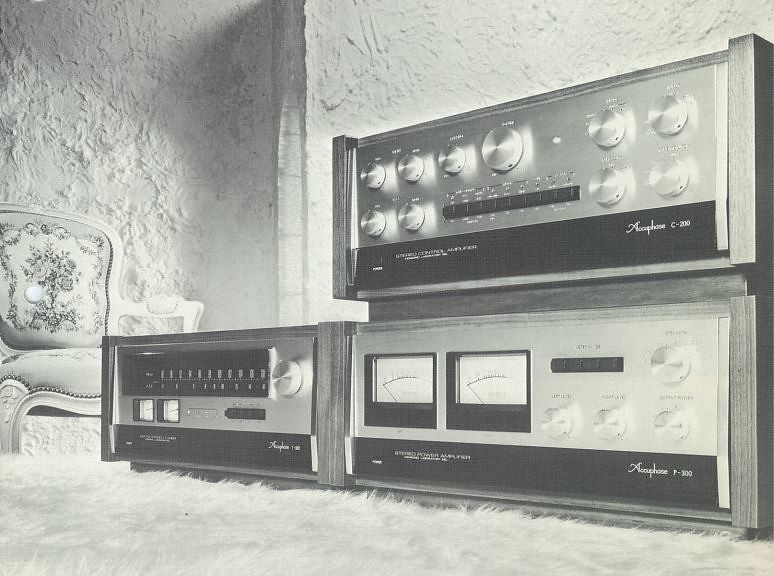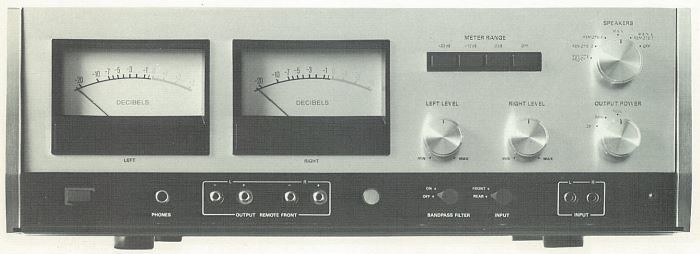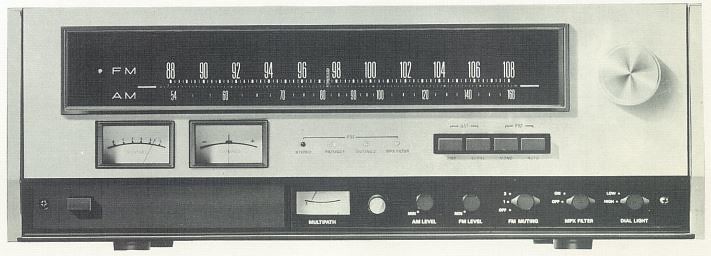Post by ChrisB on Mar 4, 2019 23:19:07 GMT
ACCUPHASE - Early Days
In 1967 Kenwood delivered the Supreme 1 amplifier – their first truly high end transistor model, it was a 33 wpc integrated amplifier with a very robust power supply, a built in 3-way frequency dividing crossover circuit and an amplifier circuit for each arm of the crossover. There were a total of nine inputs and connections for three pairs of loudspeakers and absolute phase could be inverted from a front panel switch.

Image: Kenwood Supreme 1 Integrated Amplifier, 1967
One of the Kenwood staff involved with the project was Jiro Kasuga a talented engineer, already responsible for several patents including one in 1966 relating to multiplex FM. Kenwood began to see the potential for the cheaply available high power that solid state amplifiers could achieve and followed up the Supreme 1 with a further range of Supreme amplifiers. They also decided to tool up in 1973 to produce a new high end series of equipment called the Kensonic Range and Jiro Kasuga was given the project to run. He procured the best available engineering talent from Marantz and Luxman to produce these ‘Accuphase’ units, which later gave the brand its name. The range consisted of the P-300 stereo power amplifier, the C-200 preamplifier and the T-100 AM/FM tuner. The next models on the drawing board were the E-202 integrated amplifier and an FM only tuner, the T-101 which became available in 1974.

Image: The first three Accuphase products, P-300 Power Amplifier, C-200 Preamplifier, T-100 Tuner, 1973
Depending on who you talk to, either Jiro Kasuga was unhappy with the way the range was being developed and founded a new company with Kenwood's blessing, or the company was the consequence of a series of lawsuits. Either way, Kenwood ended up with shares in what became Kensonic Laboratories Incorporated and the Accuphase units very quickly became highly regarded. On release of the E-202 and T-101 in 1974, the company published an aim commonly used today but perhaps unusual for the time: "We intend, however, to avoid non-audible frills, and concentrate our engineering on how best to reproduce the musical contents of program sources."
Today, Kenwood have been long gone from the high-end audio market but Accuphase continues to hand build in low volumes some very high quality units at their Yokohama factory. Equipment from throughout the entire life of the company is highly prized by its owners. The products have proved to be extremely robust and long lived. The, now sought after, P-300 power amplifier stayed in the product range until 1987 (as the P-300V) but many of those first 1973-built units are still in daily use.
The company have always used very conservative specifications. The product literature stated the following:
Our Views Concerning Specifications
It is our policy concerning specifications to avoid listing meaningless figures. Rather we stress the characteristics most important to best music reproduction, and consider each figure very carefully as to what it means in terms of good music. Our specification figures are then rated very conservatively, and represent what we can guarantee the user for continuous, long life performance. We acknowledge that specifications are an important factor in determining the quality of audio components, but believe that what lies behind the figures is even more important.
That Which Cannot Be Measured
We have pointed out some important audio equipment characteristics, and our opinions regarding them, but we recognise that there are certain things that cannot be measured accurately such as dynamic characteristics. For example, certain parts in a circuitry, while having the same rating, may affect sound differently. For this reason, it must be added that an audio component after its completion should be thoroughly tested for performance, as we make sure of doing at Accuphase.
Important Factors Concerning a Product
It cannot be said that an audio product is good just because it sounds good. We list the following eight points which form the fundamental designing and engineering policy regarding our products: originality, guaranteed performance specifications, mechanism design, long life dependability, safety, service and complete user satisfaction. We believe that this last point, “complete user satisfaction” is the most important since it represents the total sum value of a product.
The Original Kensonic Accuphase Models
P-300 Power Amplifier
This model came into production in August of 1973 and remained in production until 1976, though other revisions of the P-300 remained in the catalogue until 1992. It was a stereo amplifier with an output of 150 watts per channel into 8 ohms (200 w into 4 ohms) and an 8 ohm damping factor of 60 was specified. There were switchable outputs for 4 pairs of speakers, with 2 switchable pairs of stereo inputs. This includes a set of each hidden under a front panel flap along with an output level control. There was a power limiting system which allowed selection of 100%, 50% or 25% availability of total potential output. There was a relay operated speaker protection circuit and two large power meters reading output in decibels, the range of measurement selectable between 0, -10 and -20 dB. The unit measured 445 x 152 x 355 mm (whd) and weighed 25 kg.

Image: Accuphase P-300 Power Amplifier
P-200 Preamplifier
This model came into production in August of 1973 and remained in production until 1976, though other revisions of the C-200 remained in the catalogue until 1991. It was a stereo preamplifier with 2 phono and 3 line level inputs along with one for microphone and 2 tape loops. Hidden on the front panel were also additional aux and tape inputs and a headphone output socket. Voltage gain was 20 dB for the line levels, 6 dB to headphones and 60 dB for the phono inputs. Tone controls were 10 step rotaries for bass and treble (one per channel) with 2 choices of turnover frequency. The dimensions were the same as the power amplifier and weight was 14 kg.

Image: Accuphase C-200 Preamplifier
T-100 Tuner
The T-100 was an AM/FM tuner that came into production in September 1973 and remained available until 1982. The front end had a 5-gang tuning capacitor for FM and 3-gangs for AM contributing to very high levels of both selectivity and sensitivity for the time. There were fixed level and attenuated outputs, 75 ohm (via F-connector) FM aerial input, binding post 300 ohm FM and AM aerial connections and a loop to accommodate an oscilloscope. The front panel hosts multipath, signal strength and tune meters, 2-stage FM Muting, controls to trim AM and FM levels and a switchable multiplex filter. There are also AM distant and local transmitter settings and FM mono/auto buttons. The tuning dial above the controls is clear to read and well illuminated and the intensity of the dial bulbs is selectable over 2 settings. Some of the less commonly used functions were concealed below a front panel flap as for the pre and power amplifiers. The unit measured 445 x 152 x 355 mm (whd) and weighed 14 kg. The FM-only T-101 was an addition to the range and so did not replace the T-100.

Image: Accuphase T-100 AM/FM Tuner
In 1967 Kenwood delivered the Supreme 1 amplifier – their first truly high end transistor model, it was a 33 wpc integrated amplifier with a very robust power supply, a built in 3-way frequency dividing crossover circuit and an amplifier circuit for each arm of the crossover. There were a total of nine inputs and connections for three pairs of loudspeakers and absolute phase could be inverted from a front panel switch.

Image: Kenwood Supreme 1 Integrated Amplifier, 1967
One of the Kenwood staff involved with the project was Jiro Kasuga a talented engineer, already responsible for several patents including one in 1966 relating to multiplex FM. Kenwood began to see the potential for the cheaply available high power that solid state amplifiers could achieve and followed up the Supreme 1 with a further range of Supreme amplifiers. They also decided to tool up in 1973 to produce a new high end series of equipment called the Kensonic Range and Jiro Kasuga was given the project to run. He procured the best available engineering talent from Marantz and Luxman to produce these ‘Accuphase’ units, which later gave the brand its name. The range consisted of the P-300 stereo power amplifier, the C-200 preamplifier and the T-100 AM/FM tuner. The next models on the drawing board were the E-202 integrated amplifier and an FM only tuner, the T-101 which became available in 1974.

Image: The first three Accuphase products, P-300 Power Amplifier, C-200 Preamplifier, T-100 Tuner, 1973
Depending on who you talk to, either Jiro Kasuga was unhappy with the way the range was being developed and founded a new company with Kenwood's blessing, or the company was the consequence of a series of lawsuits. Either way, Kenwood ended up with shares in what became Kensonic Laboratories Incorporated and the Accuphase units very quickly became highly regarded. On release of the E-202 and T-101 in 1974, the company published an aim commonly used today but perhaps unusual for the time: "We intend, however, to avoid non-audible frills, and concentrate our engineering on how best to reproduce the musical contents of program sources."
Today, Kenwood have been long gone from the high-end audio market but Accuphase continues to hand build in low volumes some very high quality units at their Yokohama factory. Equipment from throughout the entire life of the company is highly prized by its owners. The products have proved to be extremely robust and long lived. The, now sought after, P-300 power amplifier stayed in the product range until 1987 (as the P-300V) but many of those first 1973-built units are still in daily use.
The company have always used very conservative specifications. The product literature stated the following:
Our Views Concerning Specifications
It is our policy concerning specifications to avoid listing meaningless figures. Rather we stress the characteristics most important to best music reproduction, and consider each figure very carefully as to what it means in terms of good music. Our specification figures are then rated very conservatively, and represent what we can guarantee the user for continuous, long life performance. We acknowledge that specifications are an important factor in determining the quality of audio components, but believe that what lies behind the figures is even more important.
That Which Cannot Be Measured
We have pointed out some important audio equipment characteristics, and our opinions regarding them, but we recognise that there are certain things that cannot be measured accurately such as dynamic characteristics. For example, certain parts in a circuitry, while having the same rating, may affect sound differently. For this reason, it must be added that an audio component after its completion should be thoroughly tested for performance, as we make sure of doing at Accuphase.
Important Factors Concerning a Product
It cannot be said that an audio product is good just because it sounds good. We list the following eight points which form the fundamental designing and engineering policy regarding our products: originality, guaranteed performance specifications, mechanism design, long life dependability, safety, service and complete user satisfaction. We believe that this last point, “complete user satisfaction” is the most important since it represents the total sum value of a product.
The Original Kensonic Accuphase Models
P-300 Power Amplifier
This model came into production in August of 1973 and remained in production until 1976, though other revisions of the P-300 remained in the catalogue until 1992. It was a stereo amplifier with an output of 150 watts per channel into 8 ohms (200 w into 4 ohms) and an 8 ohm damping factor of 60 was specified. There were switchable outputs for 4 pairs of speakers, with 2 switchable pairs of stereo inputs. This includes a set of each hidden under a front panel flap along with an output level control. There was a power limiting system which allowed selection of 100%, 50% or 25% availability of total potential output. There was a relay operated speaker protection circuit and two large power meters reading output in decibels, the range of measurement selectable between 0, -10 and -20 dB. The unit measured 445 x 152 x 355 mm (whd) and weighed 25 kg.

Image: Accuphase P-300 Power Amplifier
P-200 Preamplifier
This model came into production in August of 1973 and remained in production until 1976, though other revisions of the C-200 remained in the catalogue until 1991. It was a stereo preamplifier with 2 phono and 3 line level inputs along with one for microphone and 2 tape loops. Hidden on the front panel were also additional aux and tape inputs and a headphone output socket. Voltage gain was 20 dB for the line levels, 6 dB to headphones and 60 dB for the phono inputs. Tone controls were 10 step rotaries for bass and treble (one per channel) with 2 choices of turnover frequency. The dimensions were the same as the power amplifier and weight was 14 kg.

Image: Accuphase C-200 Preamplifier
T-100 Tuner
The T-100 was an AM/FM tuner that came into production in September 1973 and remained available until 1982. The front end had a 5-gang tuning capacitor for FM and 3-gangs for AM contributing to very high levels of both selectivity and sensitivity for the time. There were fixed level and attenuated outputs, 75 ohm (via F-connector) FM aerial input, binding post 300 ohm FM and AM aerial connections and a loop to accommodate an oscilloscope. The front panel hosts multipath, signal strength and tune meters, 2-stage FM Muting, controls to trim AM and FM levels and a switchable multiplex filter. There are also AM distant and local transmitter settings and FM mono/auto buttons. The tuning dial above the controls is clear to read and well illuminated and the intensity of the dial bulbs is selectable over 2 settings. Some of the less commonly used functions were concealed below a front panel flap as for the pre and power amplifiers. The unit measured 445 x 152 x 355 mm (whd) and weighed 14 kg. The FM-only T-101 was an addition to the range and so did not replace the T-100.

Image: Accuphase T-100 AM/FM Tuner












